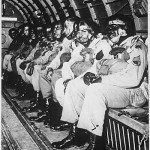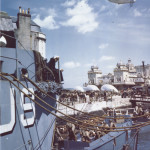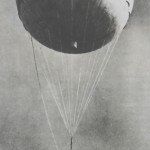SciTech Tuesday-The Jet Stream can bring more than cold air
This past winter (which will officially end on Friday 3/20) has shown how powerful the Jet Stream can be.
The Jet Stream (by which we usually mean the North Polar Jet Stream) is a relatively narrow, high velocity band of wind. Over time it tends to meander. The air north of it is cold, since it originates in the the Arctic. When in winter we have a big dip in the Jet Stream it can bring very cold air south with the dip. When the Jet Stream makes just the right (or wrong, as your perspective may determine) configuration, it can bring very cold air into contact with very moist air. This leads to heavy snowfall in a region. Since the Jet Stream moves and wobbles a bit more slowly than common storms and weather fronts, it can lead to longer patterns of weather—like the heavy winter snow totals that Boston received this winter.
Since the Jet Stream is pretty predictable throughout a season, it could in theory be used to carry floating objects with no propulsion of their own. It is at its peak from November through March.
Seventy years ago, in the winter of 1944-45, the Japanese military used the Jet Stream to do just that. They had been doing research on the Jet Stream, found that at about 9 km of altitude the wind could carry a large balloon across the Pacific (about 8,000 km) in three days. That winter they engaged a plan to deliver explosives to North America.
They called these Fu-Go, or ‘windship weapons.’ They were 10 meter hydrogen-filled balloons carrying either a 15 kg antipersonnel bomb or a set of incendiary bombs. They had a relatively sophisticated system for maintaining their altitude.
In sunshine, the helium in the balloon would warm and expand and rise higher. At night the helium would cool and the balloon would descend. The Japanese military engineers designed a control system that used an altimeter that caused the balloon to drop some of its ballast when it descended below 9 km. When the balloon rose too high, to about 12 km, it was at risk of bursting. At this altitude the control system opened a valve to vent some of the hydrogen in the balloon.
The system carried enough ballast and hydrogen to take it through 3 days and nights of travel in the Jet Stream. At that time the bombs were released and the balloon destroyed.
These balloons could carry about 450 kg of payload. The first balloons were rubberized silk, but later versions were made of mulberry paper, that leaked less hydrogen. (Silkworms eat mulberry leaves and make cocoons that are turned into silk—so in either case the balloons depended on mulberry).
The bombs were largely ineffective. During the war, US Military Intelligence estimated that about 350 of these balloons reached the US. Arrivals of balloons were kept very quiet in the press so that the Japanese would have no information about their arrival or effectiveness. The campaign of Fu-Go ended in March of 1945.
In May of 1945 a Sunday School teacher and her 5 students were on an outing in rural Oregon investigated an unusual object they found in the woods. The bomb detonated, killing them all.
Earlier in the war, from 1942 to 1944, Great Britain released 99,000 balloons meant to cause damage to the Axis. About 40% of these carried no bomb, but a very long strand of piano wire. Equipped with automatic timers and fuses, these would inflate and then descend over Germany, unspooling their wire. This was meant to short electrical lines. Shortly after their release (1,000 at a time) their were forest fires near Berlin and in Eastern Germany. One balloon knocked out power in Leipzig.
Barrage balloons were used extensively by all sides in both WWI and WWII. They were blimp-shaped balloons meant to interfere with aircraft. They had long tethers and sometimes nets spanned between them. There were only useful against low-flying craft, but there were 1,400 hundred defending England in 1940, and 3,000 in 1944. Some of them were designed to release explosive charges when the cable was contacted. These explosive-rigged barrage balloons were believed to have stopped at least 200 V1 rockets heading towards the cities of England.
- From the National Archives, a photo of African American troops preparing for a smoke jumping drop. The 555th Parachute Infantry Battalion were assigned to putting out fires in western forests that were caused by Japanese incendiary balloon bombs.
- There are barrage balloons in the background of this photo from the National Archives. In the foreground are American troops going aboard ships to head out for Operation Overlord.
- This is an image of a repaired and re-inflated balloon that had been shot down. From the National Archives.
During our busy Spring season, SciTech Tuesday posts will come every other week.
Posted by Rob Wallace, STEM Education Coordinator at The National WWII Museum







Leave a Reply